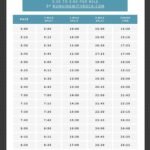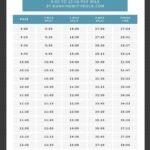Running a solid 5k race depends on your ability to pace yourself well over the course of 3.1 miles. To help you do that, I’ve created the 5k pace chart that you see below.
Finding the right 5k pace can be tricky. You need to run fast, but you also need to be able to maintain your pace for several miles.
The beginning of the race can be deceptive. You may feel good in the first mile, but if you’ve gone out a bit too fast it will catch up with you soon.
So it really pays to hone in your target pace in training and develop a good pacing strategy. You don’t want to just run by feel, because that’s an easy way to end up running too fast.
You can scroll directly to the Advanced 5k Pace Chart (5:00 to 9:00 per mile) or the Beginner 5k Pace Chart (9:00 to 13:00 per mile). Or keep reading to learn more about how to use these 5k pace charts.
Advanced 5k Pace Chart – 5:00 to 9:00 Per Mile
Here is an advanced 5k pace chart for runners that anticipate running between 5:00 and 9:00 per mile.
The chart includes five times for each pace – a) the pace itself, per mile; b) the time elapsed at the first mile split; c) the time elapsed at the second mile split; d) the time elapsed at the third mile split; and e) the finishing time for a race run at the given pace.
You can use this chart in two ways.
First, if you have a finishing time in mind, you can use it to work backwards and determine what pace you should aim for.
For example, let’s say you want to finish under 20 minutes. Look in the rightmost column – finish time – and find the row closest to 20 minutes. In this case, you’ll see a row with a finish time of 20:09 – just over 20 minutes.
Now look all the way to the left to find the corresponding pace. You’d need to run a hare faster than 6:30 per mile in order to finish the full 5k in under 20 minutes.
Second, you can begin with a goal pace and determine what your expected finishing time would be.
For example, let’s say that you’ve been training and you think you can maintain a pace of 7:45 per mile. Find the closest pace – in this case, 7:45 – and scroll to the right to see the finish time. If you run 7:45 per mile for the full 5k, you’ll finish in approximately 24:02.
In order to keep the chart manageable, I limited the number of paces. I chose 5:00 minutes as the fastest pace because few runners are going to run faster than that. It’s certainly possible, but you’d have to be highly trained and very advanced to run that fast.
I chose 9:00 minutes as the slowest pace because that’s a rough threshold that differentiates beginners from intermediate and advanced runners. Beginners will have a tough time maintaining a pace close to 9:00/mi for a full race, but anyone who’s been training for a while should be able to do so.
I chose to include paces at 15 second increments because I thought that would be enough range to make the chart useful. There are only 17 rows on the chart. If I included paces at 5 or 10 second increments there would be a much smaller range of paces included.
As a result, this may make it tough to pinpoint an exact pace if you have an exact time in mind, but you can definitely get a rough idea of what you need to run. As you get towards the faster end of the range, five or ten seconds can be a big difference. But at the slower end, there’s not a whole lot of different between 6:52/mi and 7:00/mi.
This chart is embedded from Scribd. If you view the chart on Scribd you’ll see a second page with the slower, beginner paces described below.
This document, and the images included in this post, are created under the Creative Commons Share Alike license, so feel free to re-post them on your own blog or share the images on social media. Please maintain an attribution to Running with Rock, using this url – http://runningwithrock.com/5k-pace-chart.
Beginner 5k Pace Chart – 9:00 to 13:00 Per Mile
If the previous chart include paces that are too fast for you, don’t worry. Here’s another version of the 5k pace chart designed for beginners.
This chart includes paces from 9:00 to 13:00 per mile.
Some true beginners may struggle to finish a 5k at 13:00 per mile. If that’s you, don’t worry about pace for now. You should probably stick with a run-walk strategy, in which you run for part of the race and then walk for a while to catch your breath. If you worry too much about pace, you’ll end up running too fast. In the end, that’ll make it even harder for you to finish the race with a relatively even pace.
For other novice runners, though, this chart should cover the broad range of paces that you’ll run while completing a 5k.
You can read the chart from left to right or from right to left.
From left to right, begin with a target pace in mind. Choose a pace that you have been able to run in training and that is comfortably hard. Running at this pace should force you to breath hard, but it shouldn’t force you to completely lose control of your breathing. Once you’ve figured out that pace, you can find it on the chart, look to the right, and see what your predicted finishing time is.
From right to left, you can begin with a finishing time in mind. Let’s say you’re aiming to beat 30 minutes. Find that time in the rightmost column (30:14 is closest) and then look to the left to find the target pace in the first column (9:45 per mile).
If you’re a beginner, it’s probably a good idea to start out slightly slower than expected and try to speed up throughout the race.
For example, let’s say you can run for a while at 9:30 per mile. If you don’t have the endurance to maintain that pace, you’ll die out in the final mile. Your pace will drop, and your time will be much worse than if you had started slightly slower – like 9:45/mi – and then tried to speed up once you got started.
This is called negative splitting, and it’s not the most optimal strategy for advanced runners who have trained hard at a goal pace. But it can be a great strategy for beginners who don’t have the required stamina to maintain their pace for a full 3.1 miles.
Again, feel free to share or re-use the chart above. Please include a link to this page as attribution.
What’s Your Target 5k Pace?
Hopefully these 5k pace charts helped you figure out your target pace and finishing time for your next 5k.
What’s the goal your training toward? Feel free to share in the comment section below.
I’m currently in the middle of a 5k training block (read more about it here), and I plan on running a 5k time trial in January. I’m hoping to set a new PR between 21:00 and 22:00. My current fastest 5k is 24:36.


